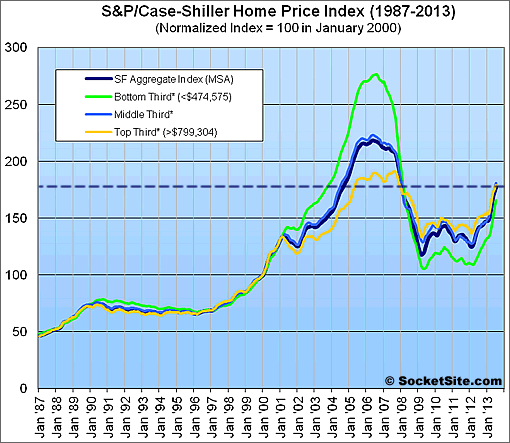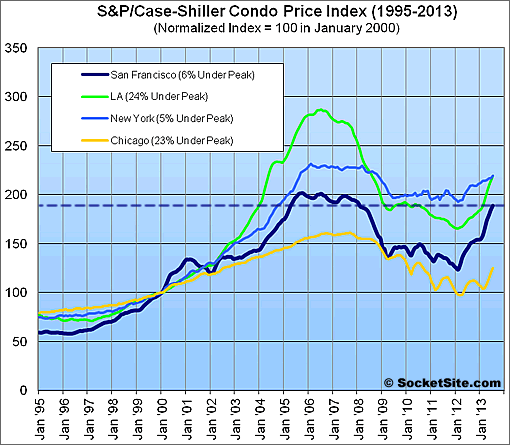While the pace of increases has continued to slow from the record setting gains recorded in April and May, single-family home and condo values in San Francisco continued to climb in July.
According to the latest S&P/Case-Shiller Home Price Index, single-family home values in the San Francisco MSA rose 2.2% from June to July 2013. Up 24.8% year-over-year, the San Francisco Index remains 19.0% below a May 2006 peak.
For the broader 10-City composite (CSXR), home values gained 1.8% from June to July and are up 12.3% year-over-year but remain 22.0% below a June 2006 peak.
The Southwest continues to lead the housing recovery. Las Vegas home prices are up 27.5% year-over-year; in California, San Francisco, Los Angeles and San Diego are up 24.8%, 20.8% and 20.4% respectively. However, all remain far below their peak levels.
Since April 2013, all 20 cities are up month to month; however, the monthly rates of price gains have declined. More cities are experiencing slow gains each month than the previous month, suggesting that the rate of increase may have peaked.
Following the increase in mortgage rates beginning last May, applications for mortgages have dropped, suggesting that rising interest rates are affecting housing. The Fed’s announcement last week that QE3 bond buying will continue for the time being may have only a limited, though favorable, impact on housing.
On a month-over-month basis, prices ticked up across all three San Francisco price tiers.

The bottom third (under $474,575 at the time of acquisition) gained 4.2% from June to July (up 40.0% YOY); the middle third gained 2.5% from June to July (up 28.6% YOY); and the top third (over $799,304 at the time of acquisition) gained 1.7% from June to July, up 18.8% year-over-year versus 18.1% in June.
According to the Index, single-family home values for the bottom third of the market in the San Francisco MSA are back near April 2003 levels (40% below an August 2006 peak); the middle third is back near August 2004 levels (19% below a May 2006 peak); and the top third is back above April 2005 levels (6% below their August 2007 peak).
Condo values in the San Francisco MSA rose 2.3% from June to July 2013 and are up 29.1% year-over-year, within 6.4% of their December 2005 peak.

Our standard SocketSite S&P/Case-Shiller footnote: The S&P/Case-Shiller home price indices include San Francisco, San Mateo, Marin, Contra Costa, and Alameda in the “San Francisco” index (i.e., greater MSA) and are imperfect in factoring out changes in property values due to improvements versus appreciation (although they try their best).
∙ Home Prices Steadily Rise in July 2013 [Standard & Poor’s]
∙ Spike In Sales Due To, Rather Than Despite, A Spike In Rates [SocketSite]
My guess is we do not surpass peak at all, or if so, by a marginal amount. My feel of the market says we’re moving sideways or even down a bit. Buyers have more inventory and sellers are not quite as bold. Market still strong with lots of buyers. Also, twitter.
I think we’ll surpass the peak before the next downturn, but when that will happen is anybody’s guess. I doubt the peak will be broken this year, but it could happen next year. Much of it depends on what happens at the Fed.
Not sure where you guys live, but in reality prices in many parts of the city are already well above where they were at the last peak, regardless of what this index might say.
Legacy Dude, as has been footnoted as nauseum the Case Shiller index is not San Francisco specific so it includes many other bay area properties. There are also many neighborhoods within San Francisco and by no means all have exceeded previous peaks.
The three lines are about to cross. You know what happens next.
Completely ignorant question: what happened in early 2001? Things seem to suddenly diverge there after more than a decade of being relatively aligned.
Loan standards really started to loosen up in 2001. It became much easier for people with bad credit to get a loan and loans with little or no downpayment became common.
Also, the dot com bubble burst, which took the wind out of the sails of the high end of the market for a while there.